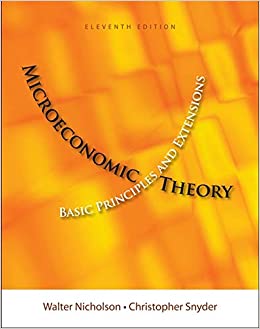
Microeconomic Theory 11th Edition by Walter Nicholson,Christopher Snyder
Edition 11ISBN: 978-1111525538
Microeconomic Theory 11th Edition by Walter Nicholson,Christopher Snyder
Edition 11ISBN: 978-1111525538 Exercise 4
As we saw in Figure 3.5, one way to show convexity of indifference curves is to show that, for any two points (x 1 , y 1 ) and ( x 2 , y 2 ) on an indifference curve that promises U = k, the utility associated with the point
 is at least as great as k. Use this approach to discuss the convexity of the indifference curves for the following three functions. Be sure to graph your results.
is at least as great as k. Use this approach to discuss the convexity of the indifference curves for the following three functions. Be sure to graph your results.
a. U(x, y) = min(x, y).
b. U(x, y) = max(x, y).
c. U(x, y) = x + y.
Reference: Figure 3.5

 is at least as great as k. Use this approach to discuss the convexity of the indifference curves for the following three functions. Be sure to graph your results.
is at least as great as k. Use this approach to discuss the convexity of the indifference curves for the following three functions. Be sure to graph your results.a. U(x, y) = min(x, y).
b. U(x, y) = max(x, y).
c. U(x, y) = x + y.
Reference: Figure 3.5

Explanation
(a)
A function is said to be convex when...
Microeconomic Theory 11th Edition by Walter Nicholson,Christopher Snyder
Why don’t you like this exercise?
Other Minimum 8 character and maximum 255 character
Character 255


